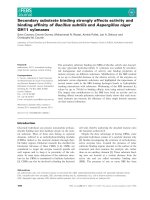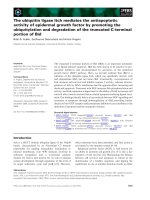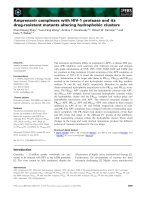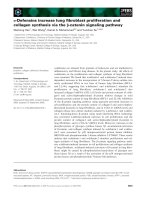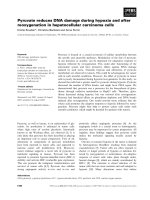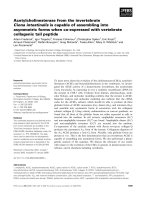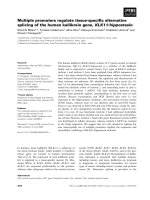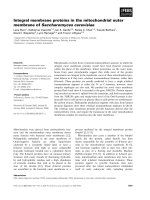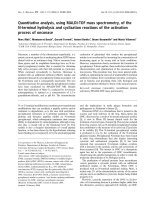Tài liệu Báo cáo khoa học: "Finding Synonyms Using Automatic Word Alignment and Measures of Distributional Similarity" pdf
Bạn đang xem bản rút gọn của tài liệu. Xem và tải ngay bản đầy đủ của tài liệu tại đây (219.08 KB, 8 trang )
Proceedings of the COLING/ACL 2006 Main Conference Poster Sessions, pages 866–873,
Sydney, July 2006.
c
2006 Association for Computational Linguistics
Finding Synonyms Using Automatic Word Alignment and Measures of
Distributional Similarity
Lonneke van der Plas & J
¨
org Tiedemann
Alfa-Informatica
University of Groningen
P.O. Box 716
9700 AS Groningen
The Netherlands
{vdplas,tiedeman}@let.rug.nl
Abstract
There have been many proposals to ex-
tract semantically related words using
measures of distributional similarity, but
these typically are not able to distin-
guish between synonyms and other types
of semantically related words such as
antonyms, (co)hyponyms and hypernyms.
We present a method based on automatic
word alignment of parallel corpora con-
sisting of documents translated into mul-
tiple languages and compare our method
with a monolingual syntax-based method.
The approach that uses aligned multilin-
gual data to extract synonyms shows much
higher precision and recall scores for the
task of synonym extraction than the mono-
lingual syntax-based approach.
1 Introduction
People use multiple ways to express the same idea.
These alternative ways of conveying the same in-
formation in different ways are referred to by the
term paraphrase and in the case of single words
sharing the same meaning we speak of synonyms.
Identification of synonyms is critical for many
NLP tasks. In information retrieval the informa-
tion that people ask for with a set of words may be
found in in a text snippet that comprises a com-
pletely different set of words. In this paper we
report on our findings trying to automatically ac-
quire synonyms for Dutch using two different re-
sources, a large monolingual corpus and a multi-
lingual parallel corpus including 11 languages.
A common approach to the automatic extrac-
tion of semantically related words is to use dis-
tributional similarity. The basic idea behind this is
that similar words share similar contexts. Systems
based on distributional similarity provide ranked
lists of semantically related words according to
the similarity of their contexts. Synonyms are ex-
pected to be among the highest ranks followed by
(co)hyponyms and hypernyms, since the highest
degree of semantic relatedness next to identity is
synonymy.
However, this is not always the case. Sev-
eral researchers (Curran and Moens (2002), Lin
(1998), van der Plas and Bouma (2005)) have used
large monolingual corpora to extract distribution-
ally similar words. They use grammatical rela-
tions
1
to determine the context of a target word.
We will refer to such systems as monolingual
syntax-based systems. These systems have proven
to be quite successful at finding semantically re-
lated words. However, they do not make a clear
distinction between synonyms on the one hand and
related words such as antonyms, (co)hyponyms,
hypernyms etc. on the other hand.
In this paper we have defined context in a mul-
tilingual setting. In particular, translations of a
word into other languages found in parallel cor-
pora are seen as the (translational) context of that
word. We assume that words that share transla-
tional contexts are semantically related. Hence,
relatedness of words is measured using distribu-
tional similarity in the same way as in the mono-
lingual case but with a different type of context.
Finding translations in parallel data can be approx-
1
One can define the context of a word in a non-syntactic
monolingual way, that is as the document in which it occurs
or the n words surrounding it. From experiments we have
done and also building on the observations made by other
researchers (Kilgarriff and Yallop, 2000) we can state that
this approach generates a type of semantic similarity that is
of a looser kind, an associative kind,for example doctor and
disease. These words are typically not good candidates for
synonymy.
866
imated by automatic word alignment. We will
refer to this approach as multilingual alignment-
based approaches. We expect that these transla-
tions will give us synonyms and less semantically
related words, because translations typically do
not expand to hypernyms, nor (co)hyponyms, nor
antonyms. The word apple is typically not trans-
lated with a word for fruit nor pear, and neither is
good translated with a word for bad.
In this paper we use both monolingual syntax-
based approaches and multilingual alignment-
based approaches and compare their performance
when using the same similarity measures and eval-
uation set.
2 Related Work
Monolingual syntax-based distributional similar-
ity is used in many proposals to find semanti-
cally related words (Curran and Moens (2002),
Lin (1998), van der Plas and Bouma (2005)).
Several authors have used a monolingual par-
allel corpus to find paraphrases (Ibrahim et al.
(2003), Barzilay and McKeown (2001)). How-
ever, bilingual parallel corpora have mostly been
used for tasks related to word sense disambigua-
tion such as target word selection (Dagan et al.,
1991) and separation of senses (Dyvik, 1998). The
latter work derives relations such as synonymy and
hyponymy from the separated senses by applying
the method of semantic mirrors.
Turney (2001) reports on an PMI and IR driven
approach that acquires data by querying a Web
search engine. He evaluates on the TOEFL test in
which the system has to select the synonym among
4 candidates.
Lin et al. (2003) try to tackle the problem of
identifying synonyms among distributionally re-
lated words in two ways: Firstly, by looking at
the overlap in translations of semantically similar
words in multiple bilingual dictionaries. Secondly,
by looking at patterns specifically designed to fil-
ter out antonyms. They evaluate on a set of 80
synonyms and 80 antonyms from a thesaurus.
Wu and Zhou’s (2003) paper is most closely re-
lated to our study. They report an experiment on
synonym extraction using bilingual resources (an
English-Chinese dictionary and corpus) as well
as monolingual resources (an English dictionary
and corpus). Their monolingual corpus-based ap-
proach is very similar to our monolingual corpus-
based approach. The bilingual approach is dif-
ferent from ours in several aspects. Firstly, they
do not take the corpus as the starting point to re-
trieve word alignments, they use the bilingual dic-
tionary to retrieve multiple translations for each
target word. The corpus is only employed to as-
sign probabilities to the translations found in the
dictionary. Secondly, the authors use a parallel
corpus that is bilingual whereas we use a multi-
lingual corpus containing 11 languages in total.
The authors show that the bilingual method out-
performs the monolingual methods. However a
combination of different methods leads to the best
performance.
3 Methodology
3.1 Measuring Distributional Similarity
An increasingly popular method for acquiring se-
mantically similar words is to extract distribution-
ally similar words from large corpora. The under-
lying assumption of this approach is that seman-
tically similar words are used in similar contexts.
The contexts a given word is found in, be it a syn-
tactic context or an alignment context, are used as
the features in the vector for the given word, the
so-called context vector. The vector contains fre-
quency counts for each feature, i.e., the multiple
contexts the word is found in.
Context vectors are compared with each other
in order to calculate the distributional similarity
between words. Several measures have been pro-
posed. Curran and Moens (2002) report on a large-
scale evaluation experiment, where they evaluated
the performance of various commonly used meth-
ods. Van der Plas and Bouma (2005) present a
similar experiment for Dutch, in which they tested
most of the best performing measures according
to Curran and Moens (2002). Pointwise Mutual
Information (I) and Dice† performed best in their
experiments. Dice is a well-known combinatorial
measure that computes the ratio between the size
of the intersection of two feature sets and the sum
of the sizes of the individual feature sets. Dice†
is a measure that incorporates weighted frequency
counts.
Dice† =
2
f
min(I(W
1
, f), I(W
2
, f))
f
I(W
1
, f) + I(W
2
, f)
,where f is the feature
W
1
and W
2
are the two words that are being compared,
and I is a weight assigned to the frequency counts.
867
3.2 Weighting
We will now explain why we use weighted fre-
quencies and which formula we use for weighting.
The information value of a cell in a word vec-
tor (which lists how often a word occurred in a
specific context) is not equal for all cells. We
will explain this using an example from mono-
lingual syntax-based distributional similarity. A
large number of nouns can occur as the subject of
the verb have, for instance, whereas only a few
nouns may occur as the object of squeeze. Intu-
itively, the fact that two nouns both occur as sub-
ject of have tells us less about their semantic sim-
ilarity than the fact that two nouns both occur as
object of squeeze. To account for this intuition,
the frequency of occurrence in a vector can be re-
placed by a weighted score. The weighted score
is an indication of the amount of information car-
ried by that particular combination of a noun and
its feature.
We believe that this type of weighting is benefi-
cial for calculating similarity between word align-
ment vectors as well. Word alignments that are
shared by many different words are most probably
mismatches.
For this experiment we used Pointwise Mutual
Information (I) (Church and Hanks, 1989).
I(W, f) = log
P (W, f)
P (W )P (f)
,where W is the target word
P(W) is the probability of seeing the word
P(f) is the probability of seeing the feature
P(W,f) is the probability of seeing the word and the feature
together.
3.3 Word Alignment
The multilingual approach we are proposing relies
on automatic word alignment of parallel corpora
from Dutch to one or more target languages. This
alignment is the basic input for the extraction of
the alignment context as described in section 5.2.2.
The alignment context is then used for measuring
distributional similarity as introduced above.
For the word alignment, we apply standard tech-
niques derived from statistical machine transla-
tion using the well-known IBM alignment mod-
els (Brown et al., 1993) implemented in the open-
source tool GIZA++ (Och, 2003). These mod-
els can be used to find links between words in a
source language and a target language given sen-
tence aligned parallel corpora. We applied stan-
dard settings of the GIZA++ system without any
optimisation for our particular input. We also used
plain text only, i.e. we did not apply further pre-
processing except tokenisation and sentence split-
ting. Additional linguistic processing such as lem-
matisation and multi-word unit detection might
help to improve the alignment but this is not part
of the present study.
The alignment models produced are asymmet-
ric and several heuristics exist to combine direc-
tional word alignments to improve alignment ac-
curacy. We believe, that precision is more cru-
cial than recall in our approach and, therefore, we
apply a very strict heuristics namely we compute
the intersection of word-to-word links retrieved by
GIZA++. As a result we obtain partially word-
aligned parallel corpora from which translational
context vectors are built (see section 5.2.2). Note,
that the intersection heuristics allows one-to-one
word links only. This is reasonable for the Dutch
part as we are only interested in single words and
their synonyms. However, the distributional con-
text of these words defined by their alignments is
strongly influenced by this heuristics. Problems
caused by this procedure will be discussed in de-
tail in section 7 of our experiments.
4 Evaluation Framework
In the following, we describe the data used and
measures applied.
The evaluation method that is most suitable
for testing with multiple settings is one that uses
an available resource for synonyms as a gold
standard. In our experiments we apply auto-
matic evaluation using an existing hand-crafted
synonym database, Dutch EuroWordnet (EWN,
Vossen (1998)).
In EWN, one synset consists of several syn-
onyms which represent a single sense. Polyse-
mous words occur in several synsets. We have
combined for each target word the EWN synsets
in which it occurs. Hence, our gold standard con-
sists of a list of all nouns found in EWN and their
corresponding synonyms extracted by taking the
union of all synsets for each word. Precision is
then calculated as the percentage of candidate syn-
onyms that are truly synonyms according to our
gold standard. Recall is the percentage of the syn-
onyms according to EWN that are indeed found
by the system. We have extracted randomly from
all synsets in EWN 1000 words with a frequency
868
above 4 for which the systems under comparison
produce output.
The drawback of using such a resource is that
coverage is often a problem. Not all words that
our system proposes as synonyms can be found in
Dutch EWN. Words that are not found in EWN
are discarded.
2
. Moreover, EWN’s synsets are not
exhaustive. After looking at the output of our best
performing system we were under the impression
that many correct synonyms selected by our sys-
tem were classified as incorrect by EWN. For this
reason we decided to run a human evaluation over
a sample of 100 candidate synonyms classified as
incorrect by EWN.
5 Experimental Setup
In this section we will describe results from the
two synonym extraction approaches based on dis-
tributional similarity: one using syntactic context
and one using translational context based on word
alignment and the combination of both. For both
approaches, we used a cutoff n for each row in our
word-by-context matrix. A word is discarded if
the row marginal is less than n. This means that
each word should be found in any context at least
n times else it will be discarded. We refer to this
by the term minimum row frequency. The cutoff is
used to make the feature space manageable and to
reduce noise in the data.
3
5.1 Distributional Similarity Based on
Syntactic Relations
This section contains the description of the syn-
onym extraction approach based on distributional
similarity and syntactic relations. Feature vectors
for this approach are constructed from syntacti-
cally parsed monolingual corpora. Below we de-
scribe the data and resources used, the nature of
the context applied and the results of the synonym
extraction task.
5.1.1 Data and Resources
As our data we used the Dutch CLEF QA cor-
pus, which consists of 78 million words of Dutch
2
Note that we use the part of EWN that contains only
nouns
3
We have determined the optimum in F-score for the
alignment-based method, the syntax-based method and the
combination independently by using a development set of
1000 words that has no overlap with the test set used in eval-
uation. The minimum row frequency was set to 2 for all
alignment-based methods. It was set to 46 for the syntax-
based method and the combination of the two methods.
subject-verb cat eat
verb-object feed cat
adjective-noun black cat
coordination cat
dog
apposition cat Garfield
prep. complement go+to work
Table 1: Types of dependency relations extracted
grammatical relation # pairs
subject 507K
object 240K
adjective 289K
coordination 400 K
apposition 109K
prep. complement 84K
total 1629K
Table 2: Number of word-syntactic-relation pairs
(types) per dependency relation with frequency >
1.
newspaper text (Algemeen Dagblad and NRC
Handelsblad 1994/1995). The corpus was parsed
automatically using the Alpino parser (van der
Beek et al., 2002; Malouf and van Noord, 2004).
The result of parsing a sentence is a dependency
graph according to the guidelines of the Corpus of
Spoken Dutch (Moortgat et al., 2000).
5.1.2 Syntactic Context
We have used several grammatical relations:
subect, object, adjective, coordination, apposi-
tion and prepositional complement. Examples are
given in table 1. Details on the extraction can be
found in van der Plas and Bouma (2005). The
number of pairs (types) consisting of a word and
a syntactic relation found are given in table 2. We
have discarded pairs that occur less than 2 times.
5.2 Distributional Similarity Based on Word
Alignment
The alignment approach to synonym extraction is
based on automatic word alignment. Context vec-
tors are built from the alignments found in a paral-
lel corpus. Each aligned word type is a feature in
the vector of the target word under consideration.
The alignment frequencies are used for weighting
the features and for applying the frequency cutoff.
In the following section we describe the data and
resources used in our experiments and finally the
results of this approach.
869
5.2.1 Data and Resources
Measures of distributional similarity usually re-
quire large amounts of data. For the alignment
method we need a parallel corpus of reasonable
size with Dutch either as source or as target lan-
guage. Furthermore, we would like to experiment
with various languages aligned to Dutch. The
freely available Europarl corpus (Koehn, 2003)
includes 11 languages in parallel, it is sentence
aligned, and it is of reasonable size. Thus, for
acquiring Dutch synonyms we have 10 language
pairs with Dutch as the source language. The
Dutch part includes about 29 million tokens in
about 1.2 million sentences. The entire corpus is
sentence aligned (Tiedemann and Nygaard, 2004)
which is a requirement for the automatic word
alignment described below.
5.2.2 Alignment Context
Context vectors are populated with the links to
words in other languages extracted from automatic
word alignment. We applied GIZA++ and the in-
tersection heuristics as explained in section . From
the word aligned corpora we extracted word type
links, pairs of source and target words with their
alignment frequency attached. Each aligned target
word type is a feature in the (translational) context
of the source word under consideration.
Note that we rely entirely on automatic process-
ing of our data. Thus, results from the automatic
word alignments include errors and their precision
and recall is very different for the various language
pairs. However, we did not assess the quality of
the alignment itself which would be beyond the
scope of this paper.
As mentioned earlier, we did not include any
linguistic pre-processing prior to the word align-
ment. However, we post-processed the alignment
results in various ways. We applied a simple lem-
matizer to the list of bilingual word type links
in order to 1) reduce data sparseness, and 2) to
facilitate our evaluation based on comparing our
results to existing synonym databases. For this
we used two resources: CELEX – a linguistically
annotated dictionary of English, Dutch and Ger-
man (Baayen et al., 1993), and the Dutch snow-
ball stemmer implementing a suffix stripping al-
gorithm based on the Porter stemmer. Note that
lemmatization is only done for Dutch. Further-
more, we removed word type links that include
non-alphabetic characters to focus our investiga-
tions on ’real words’. In order to reduce alignment
noise, we also applied a frequency threshold to re-
move alignments that occur only once. Finally, we
restricted our study to Dutch nouns. Hence, we
extracted word type links for all words tagged as
noun in CELEX. We also included words which
are not found at all in CELEX assuming that most
of them will be productive noun constructions.
From the remaining word type links we popu-
lated the context vectors as described earlier. Ta-
ble 3 shows the number of context elements ex-
tracted in this manner for each language pair con-
sidered from the Europarl corpus
4
#word-transl. pairs #word-transl. pairs
DA 104K FR 90K
DE 133K IT 96K
EL 60K PT 86K
EN 119K SV 97K
ES 119K ALL 994K
FI 89K
Table 3: Number of word-translation pairs for dif-
ferent languages with alignment frequency > 1
6 Results and Discussion
Table 4 shows the precision recall en F-score for
the different methods. The first 10 rows refer
to the results for all language pairs individually.
The 11th row corresponds to the setting in which
all alignments for all languages are combined.
The penultimate row shows results for the syntax-
based method and the last row the combination of
the syntax-based and alignment-based method.
Judging from the precision, recall and F-score
in table 4 Swedish is the best performing lan-
guage for Dutch synonym extraction from parallel
corpora. It seems that languages that are similar
to the target language, for example in word or-
der, are good candidates for finding synonyms at
high precision rates. Also the fact that Dutch and
Swedish both have one-word compounds avoids
mistakes that are often found with the other lan-
guages. However, judging from recall (and F-
score) French is not a bad candidate either. It is
possible that languages that are lexically different
from the target language provide more synonyms.
The fact that Finnish and Greek do not gain high
scores might be due to the fact that there are only
a limited amount of translational contexts (with a
frequency > 1) available for these language (as
is shown in table 3). The reasons are twofold.
4
abbreviations taken from the ISO-639 2-letter codes
870
# candidate synonyms
1 2 3
Prec Rec F-sc Prec Rec F-sc Prec Rec F-sc
DA 19.8 5.1 8.1 15.5 7.6 10.2 13.3 9.4 11.0
DE 21.2 5.4 8.6 16.1 7.9 10.6 13.1 9.3 10.9
EL 18.2 4.5 7.2 14.0 6.5 8.9 11.8 7.9 9.4
EN 19.5 5.3 8.3 14.7 7.8 10.2 12.4 9.7 10.9
ES 18.4 5.0 7.9 14.7 7.8 10.2 12.1 9.4 10.6
FI 18.0 3.9 6.5 14.3 5.6 8.1 12.1 6.5 8.5
FR 20.3 5.5 8.7 15.8 8.3 10.9 13.0 10.1 11.4
IT 18.7 4.9 7.8 14.7 7.5 9.9 12.3 9.2 10.5
PT 17.7 4.8 7.6 14.0 7.4 9.7 11.6 8.9 10.1
SV 22.3 5.6 9.0 16.4 7.9 10.7 13.3 9.3 10.9
ALL 22.5 6.4 10.0 16.6 9.4 12.0 13.7 11.5 12.5
SYN 8.8 2.5 3.9 6.9 4.0 5.09 5.9 5.1 5.5
COMBI 19.9 5.8 8.9 14.5 8.4 10.6 11.7 10.1 10.9
Table 4: Precision, recall and F-score (%) at increasing number of candidate synonyms
Firstly, for Greek and Finnish the Europarl corpus
contains less data. Secondly, the fact that Finnish
is a language that has a lot of cases for nouns,
might lead to data sparseness and worse accuracy
in word alignment.
The results in table 4 also show the difference in
performance between the multilingual alignment-
method and the syntax-based method. The mono-
lingual alignment-based method outperforms the
syntax-based method by far. The syntax-based
method that does not rely on scarce multilingual
resources is more portable and also in this exper-
iment it makes use of more data. However, the
low precision scores of this method are not con-
vincing. Combining both methods does not result
in better performance for finding synonyms. This
is in contrast with the results reported by Wu and
Zhou (2003). This might well be due to the more
sophisticated method they use for combining dif-
ferent methods, which is a weighted combination.
The precision scores are in line with the scores
reported by Wu and Zhou (2003) in a similar ex-
periment discussed under related work. The re-
call we attain however is more than three times
higher. These differences can be due to differences
between their approach such as starting from a
bilingual dictionary for acquiring the translational
context versus using automatic word alignments
from a large multilingual corpus directly. Further-
more, the different evaluation methods used make
comparison between the two approaches difficult.
They use a combination of the English Word-
Net (Fellbaum, 1998) and Roget thesaurus (Ro-
get, 1911) as a gold standard in their evaluations.
It is obvious that a combination of these resources
leads to larger sets of synonyms. This could ex-
plain the relatively low recall scores. It does how-
ever not explain the similar precision scores.
We conducted a human evaluation on a sample
of 100 candidate synonyms proposed by our best
performing system that were classified as incor-
rect by EWN. Ten evaluators (authors excluded)
were asked to classify the pairs of words as syn-
onyms or non-synonyms using a web form of the
format yes/no/don’t know. For 10 out of the 100
pairs all ten evaluators agreed that these were syn-
onyms. For 37 of the 100 pairs more than half of
the evaluators agreed that these were synonyms.
We can conclude from this that the scores provided
in our evaluations based on EWN (table 4) are too
pessimistic. We believe that the actual precision
scores lie 10 to 37 % higher than the 22.5 % re-
ported in table 4. Over and above, this indicates
that we are able to extract automatically synonyms
that are not yet covered by available resources.
7 Error Analysis
In table 5 some example output is given for the
method combining word alignments of all 10 for-
eign languages as opposed to the monolingual
syntax-based method. These examples illustrate
the general patterns that we discovered by looking
into the results for the different methods.
The first two examples show that the syntax-
871
ALIGN(ALL) SYNTAX
consensus eensgezindheid evenwicht
consensus consensus equilibrium
herfst najaar winter
autumn autumn winter
eind einde begin
end end beginning
armoede armoedebestrijding werkloosheid
poverty poverty reduction unemployment
alcohol alcoholgebruik drank
alcohol alcohol consumption liquor
bes charme perzik
berry charm peach
definitie definie criterium
definition define+incor.stemm. criterion
verlamming lam verstoring
paralysis paralysed disturbance
Table 5: Example candidate synonyms at 1st rank
and their translations in italics
based method often finds semantically related
words whereas the alignment-based method finds
synonyms. The reasons for this are quite obvious.
Synonyms are likely to receive identical transla-
tions, words that are only semantically related are
not. A translator would not often translate auto
(car) with vrachtwagen (truck). However, the two
words are likely to show up in identical syntactic
relations, such as being the object of drive or ap-
pearing in coordination with motorcycle.
Another observation that we made is that the
syntax-based method often finds antonyms such as
begin (beginning) for the word einde (end). Expla-
nations for this are in line with what we said about
the semantically related words: Synonyms are
likely to receive identical translations, antonyms
are not but they do appear in similar syntactic con-
texts.
Compounds pose a problem for the alignment-
method. We have chosen intersection as align-
ment method. It is well-known that this method
cannot cope very well with the alignment of com-
pounds because it only allows one-to-one word
links. Dutch uses many one-word compounds that
should be linked to multi-word counterparts in
other languages. However, using intersection we
obtain only partially correct alignments and this
causes many mistakes in the distributional simi-
larity algorithm. We have given some examples in
rows 4 and 5 of table 5.
We have used the distributional similarity score
only for ranking the candidate synonyms. In some
cases it seems that we should have used it to set a
threshold such as in the case of berry and charm.
These two words share one translational context :
the article el in Spanish. The distributional sim-
ilarity score in such cases is often very low. We
could have filtered some of these mistakes by set-
ting a threshold.
One last observation is that the alignment-based
method suffers from incorrect stemming and the
lack of sufficient part-of-speech information. We
have removed all context vectors that were built
for a word that was registered in CELEX with a
PoS-tag different from ’noun’. But some words
are not found in CELEX and although they are
not of the word type ’noun’ their context vec-
tors remain in our data. They are stemmed using
the snowball stemmer. The candidate synonym
definie is a corrupted verbform that is not found
in CELEX. Lam is ambiguous between the noun
reading that can be translated in English with lamb
and the adjective lam which can be translated with
paralysed. This adjective is related to the word
verlamming (paralysis), but would have been re-
moved if the word was correctly PoS-tagged.
8 Conclusions
Parallel corpora are mostly used for tasks related
to WSD. This paper shows that multilingual word
alignments can be applied to acquire synonyms
automatically without the need for resources such
as bilingual dictionaries. A comparison with a
monolingual syntax-based method shows that the
alignment-based method is able to extract syn-
onyms with much greater precision and recall. A
human evaluation shows that the synonyms the
alignment-based method finds are often missing in
EWN. This leads us to believe that the precision
scores attained by using EWN as a gold standard
are too pessimistic. Furthermore it is good news
that we seem to be able to find synonyms that are
not yet covered by existing resources.
The precision scores are still not satisfactory
and we see plenty of future directions. We would
like to use linguistic processing such as PoS-
tagging for word alignment to increase the accu-
racy of the alignment itself, to deal with com-
pounds more effectively and to be able to filter
out proposed synonyms that are of a different word
class than the target word. Furthermore we would
like to make use of the distributional similarity
score to set a threshold that will remove a lot of
errors. The last thing that remains for future work
is to find a more adequate way to combine the
872
syntax-based and the alignment-based methods.
Acknowledgements
This research was carried out in the project
Question Answering using Dependency Relations,
which is part of the research program for Inter-
act ive Multimedia Information Extraction, IMIX,
financed by NWO, the Dutch Organisation for Sci-
entific Research.
References
R.H. Baayen, R. Piepenbrock, and H. van Rijn. 1993.
The CELEX lexical database (CD-ROM). Lin-
guistic Data Consortium, University of Pennsylva-
nia,Philadelphia.
Regina Barzilay and Kathleen McKeown. 2001. Ex-
tracting paraphrases from a parallel corpus. In Meet-
ing of the Association for Computational Linguis-
tics, pages 50–57.
Peter F. Brown, Stephen A. Della Pietra, Vincent J.
Della Pietra, and Robert L. Mercer. 1993. The
mathematics of statistical machine translation: Pa-
rameter estimation. Computational Linguistics,
19(2):263–296.
K.W. Church and P. Hanks. 1989. Word association
norms, mutual information and lexicography. Pro-
ceedings of the 27th annual conference of the Asso-
ciation of Computational Linguistics, pages 76–82.
J.R. Curran and M. Moens. 2002. Improvements in
automatic thesaurus extraction. In Proceedings of
the Workshop on Unsupervised Lexical Acquisition,
pages 59–67.
Ido Dagan, Alon Itai, and Ulrike Schwall. 1991. Two
languages are more informative than one. In Meet-
ing of the Association for Computational Linguis-
tics, pages 130–137.
Helge Dyvik. 1998. Translations as semantic mirrors.
In Proceedings of Workshop Multilinguality in the
Lexicon II, ECAI 98, Brighton, UK, pages 24–44.
C. Fellbaum. 1998. Wordnet, an electronic lexical
database. MIT Press.
A. Ibrahim, B. Katz, and J. Lin. 2003. Extract-
ing structural paraphrases from aligned monolingual
corpora.
A. Kilgarriff and C. Yallop. 2000. What’s in a the-
saurus? In Proceedings of the Second Conference
on Language Resource an Evaluation, pages 1371–
1379.
Philipp Koehn. 2003. Europarl: A multilin-
gual corpus for evaluation of machine trans-
lation. unpublished draft, available from
/>Dekang Lin, Shaojun Zhao, Lijuan Qin, and Ming
Zhou. 2003. Identifying synonyms among distribu-
tionally similar words. In IJCAI, pages 1492–1493.
Dekang Lin. 1998. Automatic retrieval and clustering
of similar words. In COLING-ACL, pages 768–774.
Robert Malouf and Gertjan van Noord. 2004. Wide
coverage parsing with stochastic attribute value
grammars. In IJCNLP-04 Workshop Beyond Shal-
low Analyses - Formalisms and stati stical modeling
for deep analyses, Hainan.
Michael Moortgat, Ineke Schuurman, and Ton van der
Wouden. 2000. CGN syntactische annotatie. In-
ternal Project Report Corpus Gesproken Nederlands,
see http://lands. let.kun.nl/cgn.
Franz Josef Och. 2003. GIZA++: Training of
statistical translation models. Available from
/>P. Roget. 1911. Thesaurus of English words and
phrases.
J¨org Tiedemann and Lars Nygaard. 2004. The OPUS
corpus - parallel & free. In Proceedings of the
Fourth International Conference on Language Re-
sources and Evaluation (LREC’04), Lisbon, Portu-
gal.
Peter D. Turney. 2001. Mining the Web for synonyms:
PMI–IR versus LSA on TOEFL. Lecture Notes in
Computer Science, 2167:491–502.
Leonoor van der Beek, Gosse Bouma, and Gertjan van
Noord. 2002. Een brede computationele grammat-
ica voor het Nederlands. Nederlandse Taalkunde,
7(4):353–374.
Lonneke van der Plas and Gosse Bouma. 2005.
Syntactic contexts for finding semantically similar
words. Proceedings of the Meeting of Computa-
tional Linguistics in the Netherlands (CLIN).
P. Vossen. 1998. Eurowordnet a multilingual database
with lexical semantic networks.
Hua Wu and Ming Zhou. 2003. Optimizing syn-
onym extraction using monolingual and bilingual re-
sources. In Proceedings of the Second International
Workshop on Paraphrasing: Paraphrase Acquisition
and Applications (IWP2003), Sapporo, Japan.
873

